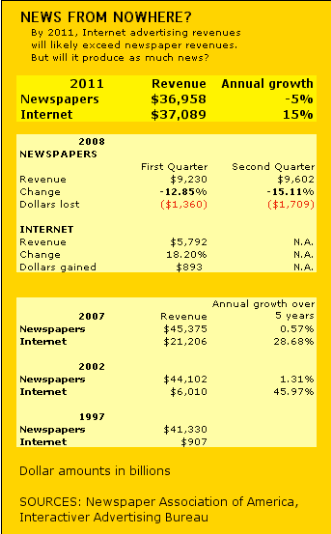2011, A News Odyssey: Digg-ing Meets Up With Digging

The crossover is close. The Internet is poised to overtake the newspaper industry in total size as an advertising medium. And the question is whether it can also overtake it as a news medium.

Whether it will replace the news lost by the switch remains to be seen.
When it comes to creating original content that appears on paper or pixel, newspapers and other print publications still account for the lion's share. Newspapers even take in a sizable share of Internet ad revenues: $3.2 billion last year, according to the Newspaper Association of American. That would be 15% out of $21.2 billion in total Internet ad revenues, if the NAA numbers can be matched up against those of the Interactive Advertising Bureau.
But news creation at newspapers is not procreating. It's dying off, with job cuts by the hundreds. The $3.2 billion in "new found'' revenue from the Internet does not cover the $6 billion of print revenue lost in this decade. Now, the newspaper industry is facing a double whammy: Print ad revenues are in free fall. And, the savior, online ad revenues is, for the first time, dropping as well. In the second quarter, the industry lost more than a fourth of its classified ad revenue. Overall, it lost a sixth of its print advertising. And it lost 2.4% of its Internet advertising. Even The New York Times, which runs one of the best Internet news sites extant, did see a gain in online revenue at its Web site in July: 1 percent.
This maelstrom has been coming for years. Newspaper makers have not been that different from auto makers. Publishers could see the advance of the online medium coming in the early '80s. Remember CompuServe and The Source? At that time, this scribe predicted in an internal report for the metropolitan daily he worked for that 20% of classified revenue would go online by 1992.
Missed the turning point by about 15 years. But the point was and is: There was plenty of time to prepare and become adept at this new medium. To keep the ad revenue in hand.
So now, it goes online. And the question is whether the new news medium will be better than the old one -- at creating news.
The biggest names in online news are, right now, The Drudge Report and The Huffington Post. But they largely are pointers to news articles all over the Net, produced by other outfits. Lots with print roots. They add big, snappy headlines, akin to tabloids you could argue, and a lot of comment, in the second case. No question, they're energetic.
But it's been a long while since you heard the name Matt Drudge, for instance, associated with breaking a news story. Two weeks of national presidential conventions and who broke the story of Alaska Gov. Sarah Palin's 17-year-old daughter being pregnant? The McCain campaign. There is a Net news story behind that, though. A writer for the Daily Kos had stitched together a series of photos of Gov. Palin when she was supposed to be pregnant with the child that was born this year with Down syndrome. She didn't look pregnant. The implication: Gov. Palin was not carrying child. She was covering up for her daughter.
So, the McCain campaign rushes out with the "better" news: that the daughter is pregnant, right now. She couldn't have been pregnant then. Gov. Palin's protected.
Such is the nature of news in the Internet era. Hundreds of bloggers at each convention. Maybe getting things right. Maybe getting things wrong. But in the end, the truth emerges, even if the target is the one who has to produce an unexpected story, to disprove an earlier one.
Yes, this is not on the same scale as the long, pain-staking research done by muckraking icons like I.F. Stone, who would probably be scouring federal databases and publishing his newsletter online, today. Sure, bloggers do not make a lot of money (see Gawker pay scale in "166 Frames of Fame."). Many work long hours at low or even no pay. Mayhill Flower did wind up working at Huffington Post, however.
This may just be how it works. An outfit (and smart entrepreneur like Ariana) rides in town, by riding on top of everyone else's content. Then, as the business grows (see also TV Newsday) it starts generating more original work of its own, with its own staffers. This way, they keep on top on all the competition, and have to beat it, too.
Then, comes along the democratization of all the pieces of news and opinion being generated everywhere. If you see something you like, you Digg it. And the story that gets the most votes, moves to the top. Which gives its more eyeballs, which keeps it at the top, until something better or more timely comes along.
Now, editors have to prove their eyes and judgment are better than the crowd's. Paid journalists have to dig harder, if they are going to stand out. Original work still wins -- even if news is not all about popularity counts. The analysis of big public issues and the rooting out of corruption may take a new economic model (see ProPublica). Or more governors from Alaska (or not).
We're still in the celebrity news aggregation period, of this new news medium. Up next: Former New Yorker and Talk chief Tina Brown, with The Daily Beast, soon to debut. Maybe this will be one of those pitbulls that does wear lipstick (no more Palin references).
Over the next three or four years, news aggregation will start to get replaced by news creation. Bloggers will band together to do long-painstaking research that requires legwork and lots of interviews. More tools like Digg (founded Dec. 4, 2004) will come up to sort all the stuff that gets created by importance, not just popularity.There's still time for someone to figure out a meter that works for that and, with the growth of Internet advertising unabated, rewards news that makes a substantive difference in how this democracy is conducted.